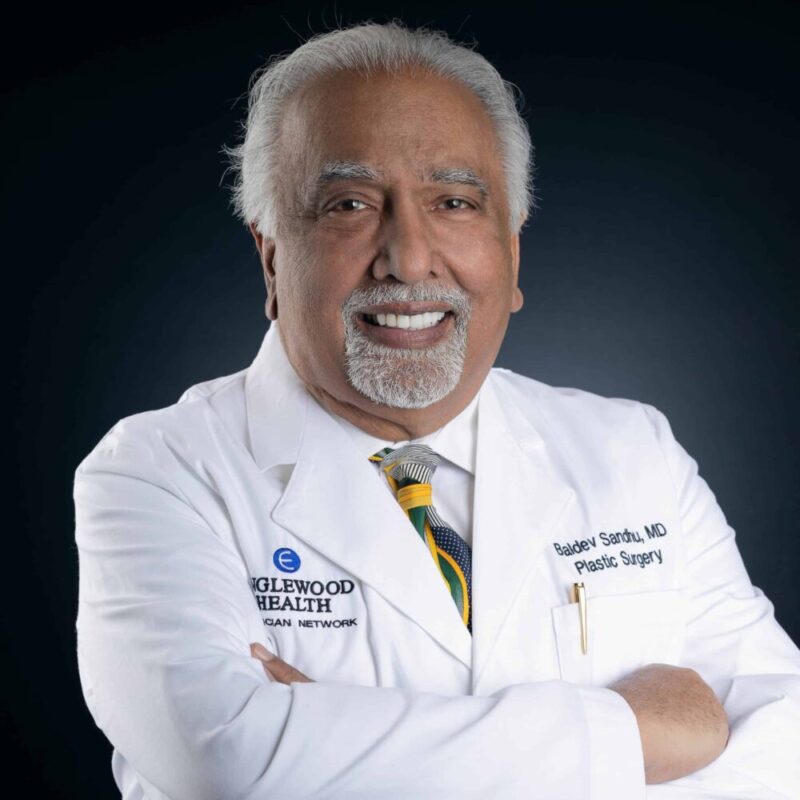
New Jersey Hair Transplant
Your Real Hair Restored Naturally!
Paramus Medical Center
30 W. Century Rd. Ste. 220, Paramus, NJ
• 1201 Sycamore Ave. Tinton Falls, NJ 07724
• 410 Amboy Ave, Woodbridge, NJ 07095

BalDév Sandhu, MD answers the most commonly asked questions about hair transplant in this Hair Transplant NJ FAQ
FUT is simply another name for the strip procedure which leaves a large scar on the
back of the head. The follicular units are transplanted after they have been chopped
out of the strip which is a very inexact process and damages many of the follicles.
NEOGRAFT is the name of a machine that first popularized Follicular Unit Extraction (FUE).
FUE allows the donor hair to be extracted with precision and without the necessity of a
long incision, sutures and scar involved with the strip procedure.
There are newer, more versatile machines such as the DeVroye and U machines
developed by surgeons that build on the Neograft technology which I now use more often.
The hair follicles that are transplanted are genetically-resistant against baldness so they will continue to grow over your lifetime.
However hair transplant does not stop the progression of male pattern baldness. Ongoing hair loss on different areas of your head, may require another transplant procedure in the future.
When work is done in areas where there is existing hair, you could possibly lose some of those hairs. It’s sometimes referred to as ‘shock loss’ and happens especially if the hair is weak and miniaturizing. If your hair is too weak, it may not return, but if it’s strong, then it’ll remain.
Honestly, you’ll probably be pleasantly surprised. When you read about the procedure, it seems a tad gruesome. The fact is, there’s no pain with the surgery, just a little discomfort. Think of it like getting a filling done at the dentist. You have anaesthetic so there’s no pain but you may not like being at the dentist.
The discomfort comes from being in the chair for up to ten hours. Though you will get regular breaks.
Post-op, you might experience some mild pain. But nothing that standard painkillers can’t manage for a few days, just like with any minor surgical procedure.
You’ll generally only need to take it easy for a couple of days after the procedure. Take it easy while allowing your body to recover. Avoid over-exerting yourself and avoid the gym, running and any sexual activity for at least seven days. After this, you can resume all regular activities. Most patients resume work after two-three days if there is no manual labor involved.
Follicular unit grafting requires tiny incisions to the recipient area. any resultant scarring is generally invisible to the untrained eye.
You’ll need to wear a hat – due to the healing process or 5-10 days. The surgical area will be red and a little noticeable for a short time.
After the procedure, the hair grows in very slowly but as time passes, you’ll probably have people asking if you’ve lost weight. They’ll notice ‘something’ but won’t be able to pinpoint the physical change in you.
No need to tell anyone. Lots of guys get away with no one figuring it out.
Hair growth is a slow process, even in a person who doesn’t experience hair loss. After the procedure, signs of growth can take from three to four months due to the hair’s natural growing cycle. Beyond that, it’s all gravy! As your hair starts to grow, noticeable effects will take around eight months. At one year post-op, you’ll see the full effect.
Top tip: Keep your expectations in check and remember that hair is a bit like money: you will always want more.
This really depends on you. A useful approach is to build a solid foundation ahead of surgery. Minimize your hair loss through medical treatment, with a drug such as finasteride. This will give you a sense of your hair’s stability, and prevent against further loss.
No vitamins, shampoos or hair conditioner has been shown to stop male pattern baldness. Minoxidil, a topical application, was approved by the FDA for hair loss in the crown area. At best it produces some microscopic fuzz, visible only on high power photographs. Finasteride, a daily pill, works but requires a lifetime commitment to a medication that has significant sexual side-effects in many men.
We have available a compounded topical application of minoxidil/finasteride which avoids the side effects but still requires a commitment to daily lifetime use.
There are three obvious variants at play here. Where you go to get it done, who performs the procedure, and the size of the area you need treating.
First, location. Travelling abroad has become popular with men seeking this surgery on the cheap, with options in Thailand, Turkey and India. Unfortunately, as with almost everything in life, you get what you pay for. Better to save up for longer and get something lasting than run the risk of a botch job. Also when you consider the additional costs of airfare, hotels and time out of work it does not add up to significant savings.
Second, the ‘who’ question. In the USA, there are countless reputable hair transplant surgeons. Some will charge more based on reputation, their surgery’s location and how up to date the equipment is that they use. Others will charge less and be just as effective and this is where extensive research comes in. Do your research and weigh up all options.
Lastly, the treatment area. If you only need to resolve a thinning, receding hairline, the cost will likely be in the region of $5,000-$8,000. If your hair is a long way gone and you need the entire top done then it’s likely you’re looking at a couple of larger procedures.
The million-dollar question. Anyone you entrust with your precious donor site should have done at least 100 hair transplant surgeries. Most importantly ask if the surgeon himself will be doing all the extractions! This will weed out all the clinics run by entrepreneurs (even those with an MD after their name).
There are no little robots running over your head. Artas is simply FUE where a guided articulating arm, operated by the surgeon is extracting the follicular units. After the machine does the core incising the grafts still need to be removed and implanted by hand. The Artas company charges approximately $1.75 each time the unit attempts to mark and incise the graft. It costs $250,000 to buy the machine as well as an annual maintenance contract of $27,000 to keep the machine running. All these costs have to be passed onto the patient and most patients find the additional costs prohibitive. Few surgeons have made this the procedure of choice for their patients.
We offer monthly payment plans, based upon your income and credit score, through our finance partners.
Hair Transplant NJ FAQ – Dr. Sandhu answered the most commonly asked questions that he found relevant to other patients such as yourself. However, he did not cover all the questions he receives. If you have any other questions, please schedule a complimentary appointment with Dr. Sandhu @ 201-337-6286. Thank you for your interest in learning more and reading the Hair Transplant NJ FAQ
BalDev Sandhu, MD
Hair Transplant Authority & Specialist
Attending Plastic Surgeon
Hoboken University Medical Center
Dr. Sandhu has performed Hair Transplants for over 20 years and is a diplomate of the American Board of Plastic Surgery. He was elected a member of the American Society of Plastic Surgeons and also, a member of the NJ Society of Plastic Surgeons.


